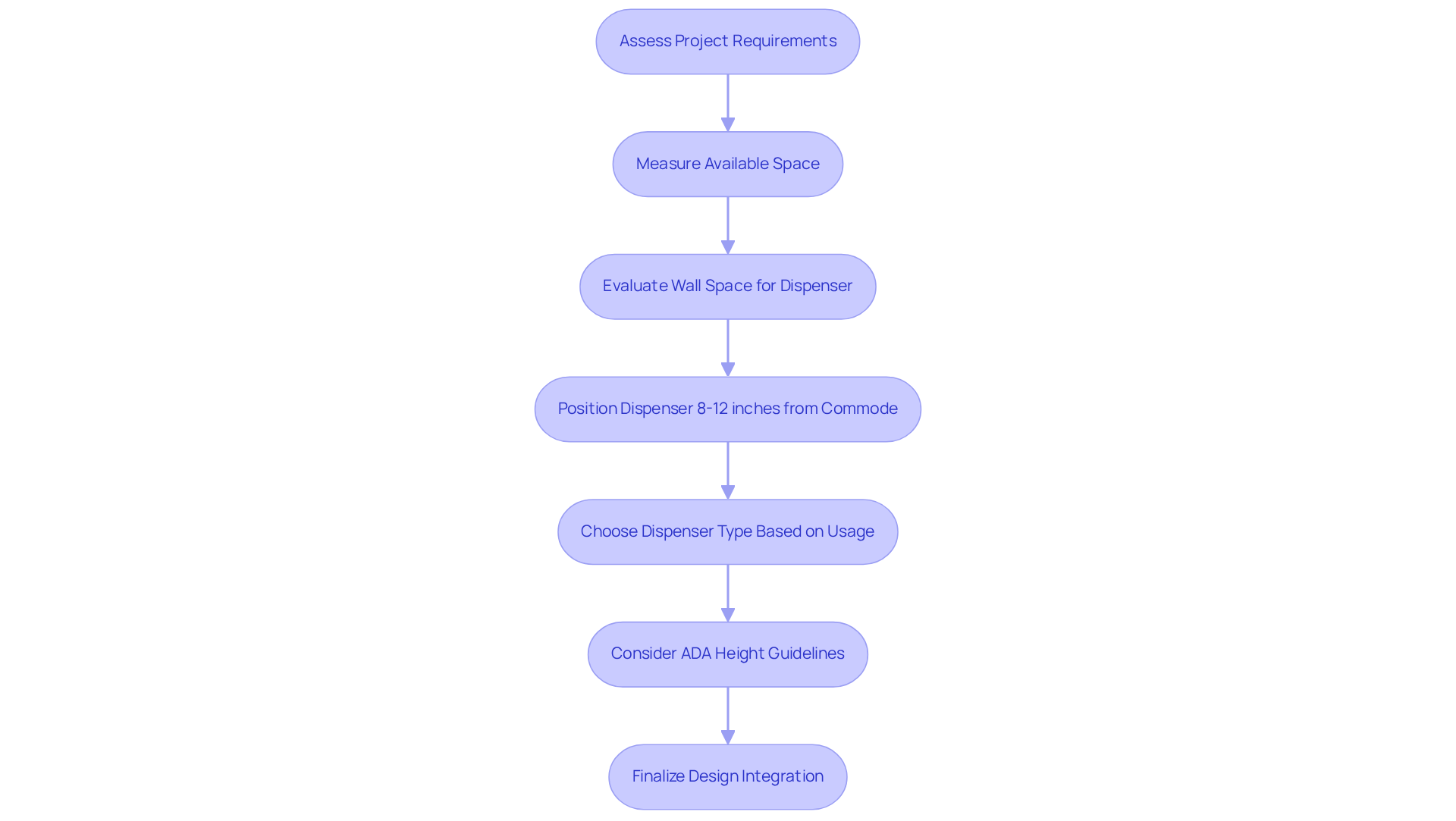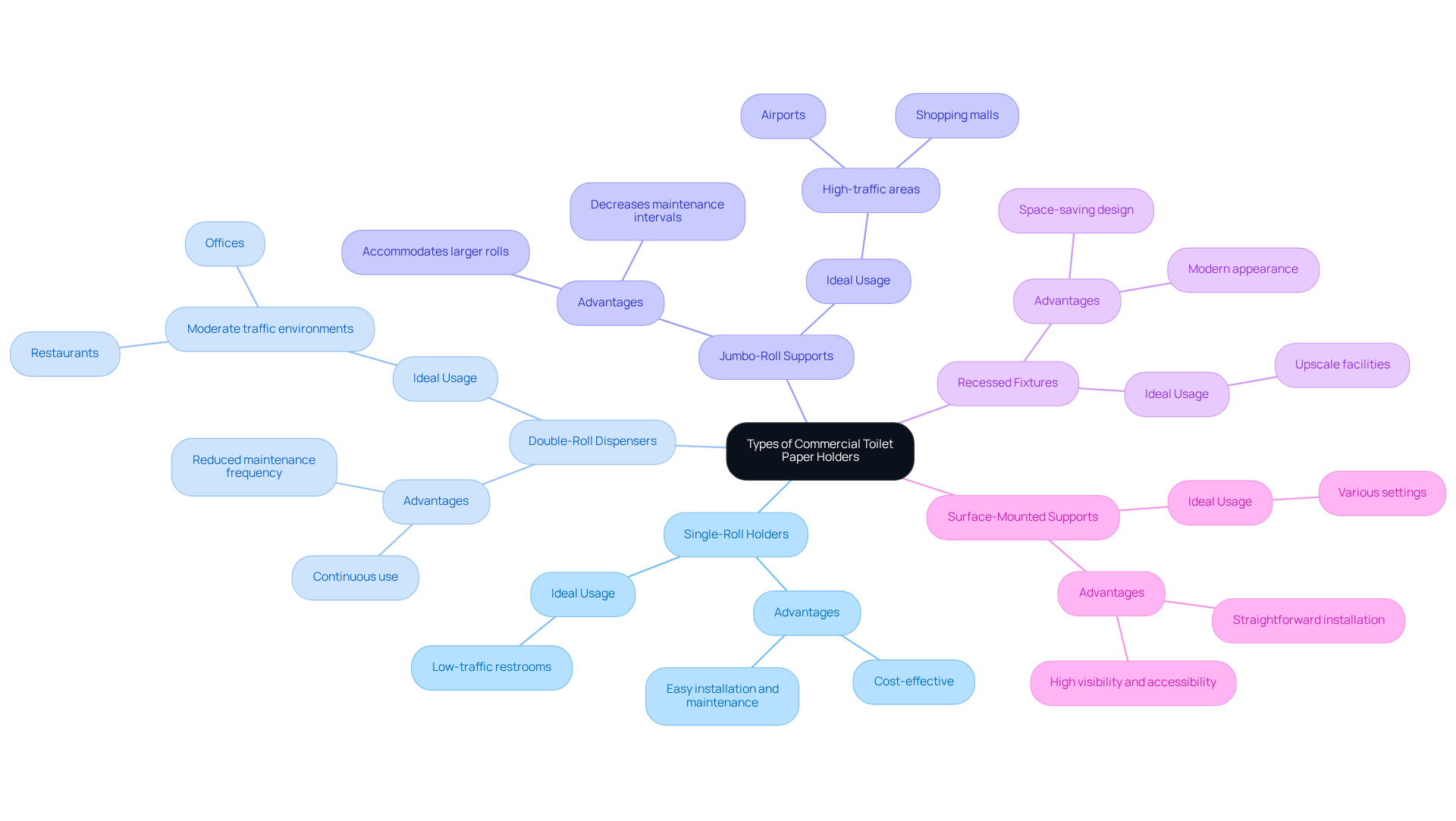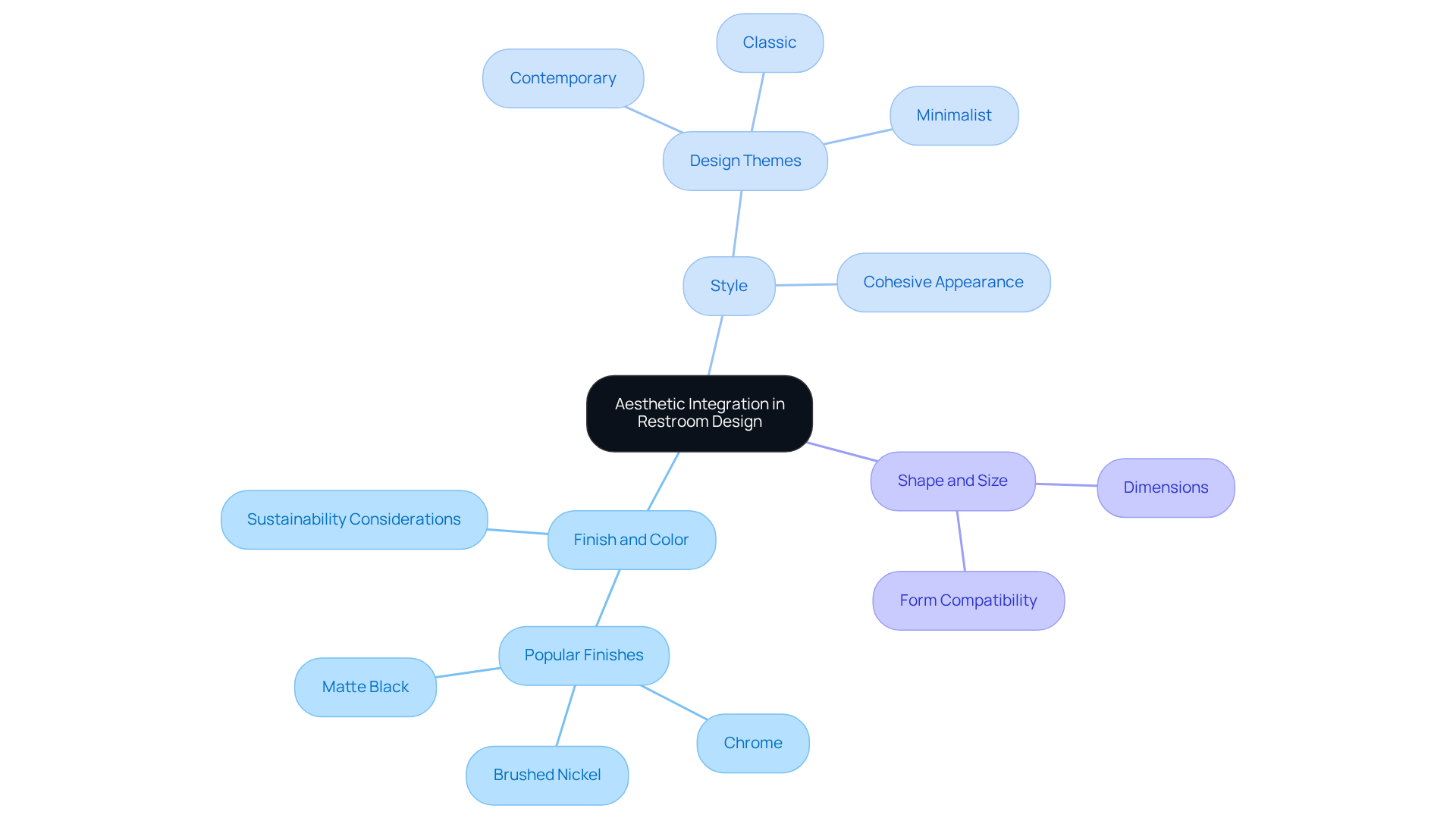Overview
This article outlines five essential steps for selecting the right commercial toilet paper holder. It emphasizes the importance of:
- Assessing project requirements
- Exploring different types
- Evaluating materials
- Considering aesthetic integration
- Planning for installation and maintenance
Each step is supported by practical advice that underscores the significance of functionality, user experience, and design coherence. This ensures that the chosen holder meets both operational needs and aesthetic standards in restroom environments. Furthermore, by following these steps, you can ensure a seamless integration of the toilet paper holder into your restroom design.
Introduction
Selecting the right commercial toilet paper holder may appear to be a minor detail, yet it is pivotal in enhancing both the functionality and aesthetic appeal of any restroom. With a diverse range of options available—from single-roll to jumbo-roll dispensers—understanding the specific needs of a space can significantly elevate user experience and operational efficiency.
However, the challenge lies in navigating the myriad factors that influence this decision, including:
- Space constraints
- User volume
- Material durability
- Design integration
What essential steps can be taken to ensure that the chosen holder not only meets practical requirements but also harmonizes with the overall restroom design?
Assess Project Requirements and Space Constraints
Begin by accurately measuring the available space in your restroom. It is crucial to consider the measurements of the wall allocated for the tissue dispenser, ensuring adequate space to prevent blocking other fittings. For optimal access, tissue dispensers should be positioned 8-12 inches in front of the commode bowl edge. In busy bathrooms, opting for larger, more robust dispensers, such as double-roll options, will effectively manage heightened usage. Assess the expected volume of users alongside any existing design elements, such as wall finishes or adjacent fixtures, that may influence your choice.
The standard height for a tissue dispenser is generally 26 inches from the ground; however, ADA guidelines suggest a height ranging from 19 to 36 inches to guarantee accessibility. This comprehensive evaluation will assist you in selecting a fixture that not only integrates smoothly into the bathroom design but also enhances functionality and user experience. Architects often emphasize the importance of thoughtful space planning, noting that improper placement can lead to awkward reaches or accidents, ultimately impacting user satisfaction.

Explore Different Types of Commercial Toilet Paper Holders
When selecting a commercial toilet paper holder, it is essential to consider the specific needs of your bathroom environment. The primary types available include:
- Single-Roll Holders: These compact holders are best suited for low-traffic restrooms, offering ease of installation and maintenance. Typically accommodating standard rolls, they present a cost-effective solution for facilities with minimal usage. Statistics indicate that single-roll dispensers are frequently adequate for restrooms with low usage, providing a practical answer for such settings.
- Double-Roll Dispensers: Designed for moderate traffic, double-roll dispensers enable continuous use without the need for frequent refills. This option strikes a balance between convenience and cost, making it a preferred choice in environments like offices and restaurants. Many facilities opt for double-roll dispensers due to their ability to reduce maintenance frequency while still ensuring an adequate supply.
- Jumbo-Roll Supports: Perfect for high-traffic areas, jumbo-roll supports can accommodate larger rolls, significantly decreasing maintenance intervals. This feature is particularly advantageous in busy locations such as airports and shopping malls, where restroom usage is high.
- Recessed Fixtures: Installed into the wall, recessed fixtures save space and offer a sleek, modern appearance. They serve as an excellent choice for upscale facilities aiming for a minimalist design.
- Surface-Mounted Supports: These supports are straightforward to install and maintain, presenting a practical option across various settings. Their visibility ensures accessibility, which is crucial in public facilities.
When evaluating these options, it is important to consider user volume and maintenance frequency. For instance, while single-roll dispensers are often sufficient for bathrooms with low usage, a commercial toilet paper holder that accommodates double-roll and jumbo-roll options is favored in high-traffic environments to ensure a seamless experience for users. By understanding the advantages and disadvantages of each type, including the cost-efficiency of single-roll devices compared to the convenience of double-roll systems, you can make an informed decision that enhances both functionality and aesthetics in your bathroom design.

Evaluate Materials and Durability for Longevity
When selecting a toilet paper holder, it is essential to consider the following materials:
- Stainless Steel: This material is highly durable and resistant to rust, making it ideal for humid environments.
- Plastic: While lightweight and cost-effective, plastic may not withstand heavy use as well as metal options. High-density polyethylene (HDPE) and ABS plastic are recommended for their strength and durability, making them viable choices for budget-conscious projects.
- Brass: Offering a classic look and durability, brass requires regular maintenance to prevent tarnishing.
- Aluminum: Lightweight and rust-resistant, aluminum is suitable for various designs.
Assessing the expected usage is crucial. Choose a material that balances durability with aesthetic appeal. Furthermore, ensure that the device is simple to clean and maintain, as this will enhance the overall cleanliness of the washroom.

Consider Aesthetic Integration with Restroom Design
Aesthetic integration is essential for creating a cohesive bathroom environment. Key considerations include:
- Finish and Color: Opt for finishes that harmonize with other fixtures, such as faucets and sinks. Popular choices, including chrome, brushed nickel, and matte black, enhance visual appeal and align with current trends emphasizing sustainability and user comfort.
- Style: The commercial toilet paper holder should match the overall design theme of the bathroom. Whether the space is contemporary, classic, or minimalist, selecting a stand that enhances the aesthetic will create a cohesive appearance.
- Shape and Size: The holder's dimensions and form should fit seamlessly within the bathroom layout, ensuring it does not dominate the space or clash with other elements.
Incorporating these factors can significantly elevate the washroom's visual appeal while ensuring functionality. For instance, a well-designed lavatory at Lacuna Space in California showcased how The Splash Lab's fixtures harmonized with the overall design, enhancing user experience. As highlighted by industry specialists, coordinating finishes and styles, including the selection of a commercial toilet paper holder, is essential for attaining a refined appearance in commercial washrooms. By thoughtfully integrating sanitary fixtures with design themes, architects can create spaces that are not only functional but also visually appealing.

Plan for Installation and Ongoing Maintenance
To ensure a successful installation and maintenance routine for toilet paper holders in commercial restrooms, it is imperative to follow these essential steps:
Installation: Begin by utilizing a level to mark the correct height for the holder, typically set at 26 inches from the floor, while maintaining a distance of 8 to 12 inches from the toilet. It is crucial to securely attach the support to a stud or utilize appropriate wall anchors to guarantee stability.
Maintenance: Regular inspections of the support for signs of wear and tear are vital, ensuring it remains securely fastened. Cleaning the holder with non-abrasive cleaners will help maintain its appearance and hygiene, which is particularly crucial in high-traffic environments. As noted in industry insights, consistent maintenance is essential for preventing unexpected plumbing issues in commercial restrooms.
Restocking: Establish a regular timetable for replenishing bathroom tissue, especially in busy locations where demand is significantly higher. In line with industry standards, maintenance frequency for tissue dispensers in such environments should occur at least weekly to avoid shortages and ensure user satisfaction. Brent Otsuka, a Manager of Interior Design at Fentress Architects, emphasizes that maintaining cleanliness in restrooms is vital for customer satisfaction and repeat business.
By proactively planning for installation and ongoing maintenance, you can ensure that toilet paper holders remain functional, hygienic, and visually appealing over time.

Conclusion
Selecting the right commercial toilet paper holder is essential for enhancing both functionality and aesthetics in restroom design. By carefully considering the specific needs of the space, including user volume and maintenance frequency, businesses can ensure they choose a holder that not only meets practical requirements but also complements the overall environment.
Throughout this discussion, key factors such as:
- Assessing project requirements
- Exploring different types of holders
- Evaluating materials for durability
- Ensuring aesthetic integration
have been highlighted. Each step plays a vital role in making an informed decision that enhances user experience and satisfaction. Furthermore, the importance of installation and ongoing maintenance has been emphasized, illustrating how these practices contribute to the longevity and cleanliness of restroom facilities.
Ultimately, investing time in selecting the appropriate toilet paper holder can significantly impact the overall restroom experience. By prioritizing both functionality and design, businesses can create a welcoming atmosphere that reflects their commitment to quality and user comfort. Taking these considerations into account will lead to a more efficient and visually appealing restroom environment, reinforcing the significance of thoughtful planning in commercial restroom design.
Frequently Asked Questions
What is the first step in selecting a tissue dispenser for a restroom?
The first step is to accurately measure the available space in the restroom, particularly the wall allocated for the tissue dispenser, ensuring there is adequate space to prevent blocking other fittings.
How far should tissue dispensers be positioned from the commode bowl edge?
Tissue dispensers should be positioned 8-12 inches in front of the commode bowl edge for optimal access.
What type of tissue dispensers are recommended for busy bathrooms?
Larger, more robust dispensers, such as double-roll options, are recommended for busy bathrooms to effectively manage heightened usage.
What is the standard height for a tissue dispenser, and what do ADA guidelines suggest?
The standard height for a tissue dispenser is generally 26 inches from the ground, while ADA guidelines suggest a height ranging from 19 to 36 inches to ensure accessibility.
Why is it important to consider space planning when installing a tissue dispenser?
Thoughtful space planning is important because improper placement can lead to awkward reaches or accidents, ultimately impacting user satisfaction.
What are the primary types of commercial toilet paper holders available?
The primary types are: Single-Roll Holders, Double-Roll Dispensers, Jumbo-Roll Supports, Recessed Fixtures, Surface-Mounted Supports.
When are single-roll holders most appropriate?
Single-roll holders are best suited for low-traffic restrooms, offering ease of installation and maintenance, and are often sufficient for facilities with minimal usage.
What are the advantages of double-roll dispensers?
Double-roll dispensers are designed for moderate traffic, enabling continuous use without frequent refills, making them a preferred choice in environments like offices and restaurants.
What is the benefit of using jumbo-roll supports?
Jumbo-roll supports are perfect for high-traffic areas as they accommodate larger rolls, significantly decreasing maintenance intervals, which is advantageous in busy locations.
What are recessed fixtures, and when are they recommended?
Recessed fixtures are installed into the wall, saving space and offering a sleek, modern appearance, making them an excellent choice for upscale facilities aiming for a minimalist design.
Why are surface-mounted supports considered practical?
Surface-mounted supports are straightforward to install and maintain, presenting a practical option across various settings, with their visibility ensuring accessibility in public facilities.




